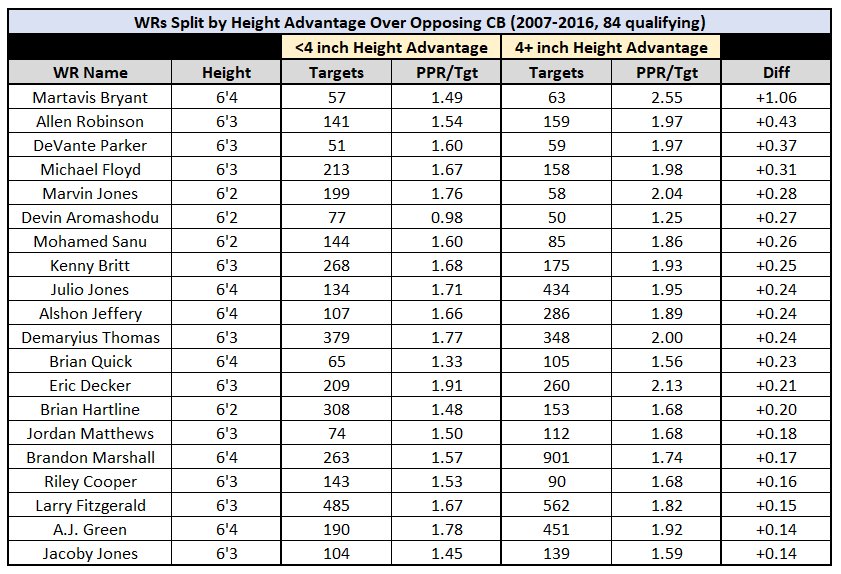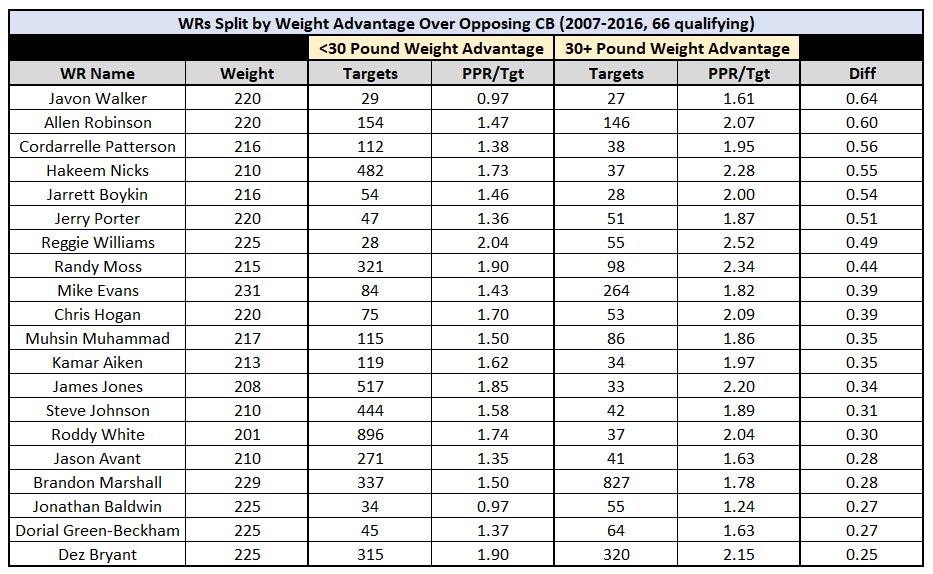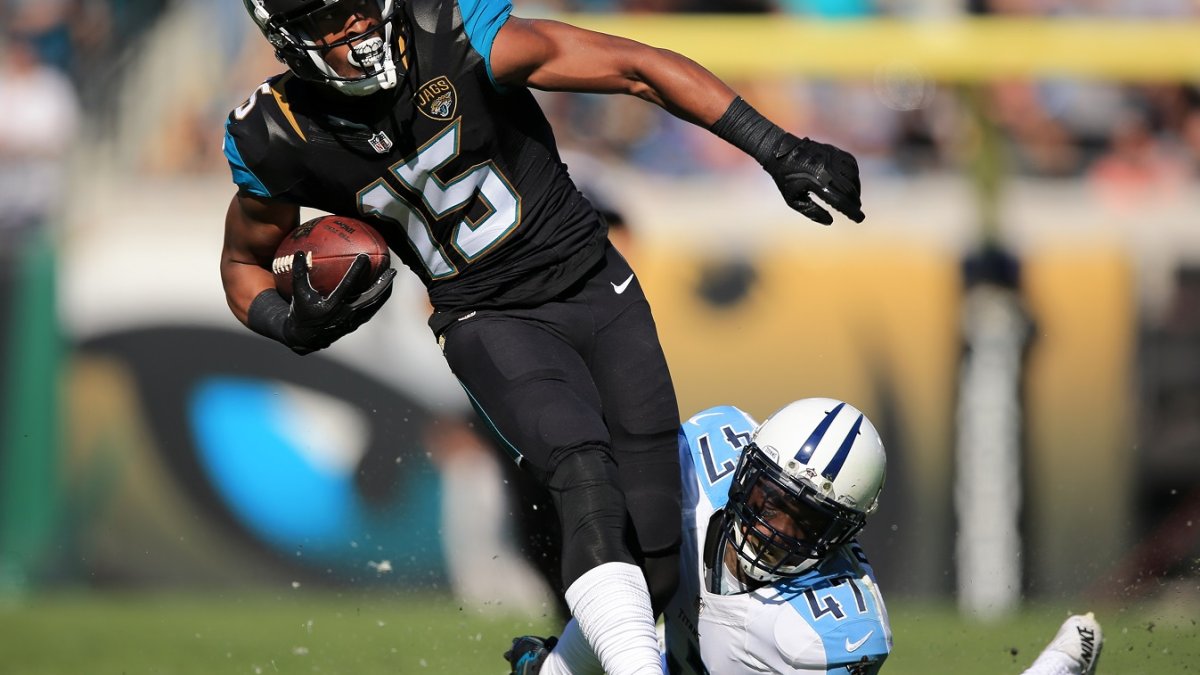So far, we’ve looked at wide receivers who are atypically dependent upon the speed of their opposing cornerback. (Hello, Brandin Cooks.) Then we looked at wide receivers who are atypically dependent upon the skill level of their opposing cornerback. (Hello, Dez Bryant.) Today, I wanted to look at wide receivers who are more cornerback-sensitive when factoring in height and weight advantages over their opposing cornerback.
If a wide receiver especially beats up on smaller cornerbacks, this represents a significant edge for those of us playing in DFS. DFS salaries are based primarily on team-matchups or a player’s mean production, and likely never take these two factors into account. By looking at Jeff Ratcliffe’s WR/CB Matchup Chart each week, we can identify which cornerback each wide receiver is projected to run the majority of their routes against and what that receiver’s weight or height advantage might be over them. The below charts identify wide receivers to especially target when the height/weight advantage is significant.
Taller wide receivers tend to be more efficient than shorter wide receivers in general. In a very linear manner, wide receivers also average more points when given a significant height advantage over their opposing cornerback. Over the past 10 seasons, wide receivers average 1.74 fantasy points per target when facing off against a cornerback they are at least four inches taller than. The rest of the time they average 1.65 fantasy points per target.
Over the past 10 seasons, here are the 20 wide receivers most sensitive to the height of their opposing cornerback:

Much like with height, weight advantage seems to impact fantasy efficiency in a linear manner. Over the past 10 seasons, when a wide receiver was more than 30 pounds heavier than the opposing cornerback, they averaged 1.75 fantasy points per target. The rest of the time they averaged 1.66. Though note, we should be a little more hesitant when looking at weight in wide receiver vs. cornerback matchups. Although the correlation appears high, it’s a little less practical than looking at height, considering a player’s weight fluctuates year-to-year but is never updated after a player joins the league.
Over the past 10 seasons, here are the 20 wide receivers most sensitive to the weight of their opposing cornerback:

What does this mean for fantasy?
In redraft leagues, I’m likely not looking too much into this data. In DFS, I’ll give a slight edge to wide receivers who have a significant height or weight advantage over the opposing cornerback they’re likely to run the majority of their routes against. If the wide receiver also made one of the above charts, I’ll give them an even greater boost in my rankings.
Martavis Bryant is our most height-sensitive wide receiver over the past decade. Strangely (considering the high correlation between height and weight) he didn’t rank as highly when given a significant weight advantage. Perhaps that changes this year, after he added 17 pounds (of what looks like pure muscle) during his suspension-induced gap year. For DFS, I’ll give Bryant a boost when facing off against a shorter cornerback. For redraft leagues, looking at my rankings, it appears I’m higher on Bryant (no pun unintended) than nearly anyone. I wrote about my optimism earlier this year.
Two players made both of the above charts: Allen Robinson and Brandon Marshall. Marshall at age 33 and Robinson (4.60-second 40-yard dash) are two wide receivers who win their routes more on physicality than speed, so their rankings above make some sense. I’d be more inclined to play them in matchups where they are expected to run the majority of their routes against significantly smaller cornerbacks.
I’m not reading too much into Marshall here, outside of just making a mental note for DFS. For Robinson, I think this is the final straw. He’s far too cornerback- and gamescript-dependent for me to roster in redraft or dynasty leagues. Rather, I’ll gain heavy exposure to Robinson in DFS during favorable-matchup weeks.
He was both our second-most height-sensitive and weight-sensitive wide receiver over the past decade. He’s also struggled mightily against top cornerbacks throughout his career. On 60 career targets against top-20-graded cornerbacks, Robinson has caught only 20 passes for 193 yards and one touchdown. Among all 116 wide receivers over the past decade to see at least 40 such targets, Robinson’s 0.76 PPR per-target average ranks second-worst. To top it all off, no wide receiver scored a higher percentage of his fantasy points when trailing by seven or more points over the past three seasons.
In DFS, I’ll be looking for a number of different potential positive trends regarding Robinson. First I’ll look at which cornerback he’s projected to run the majority of his routes against. If that cornerback is one of our highest-graded for the season, I’ll avoid him completely. If the cornerback is middling to poor by PFF coverage grade, Robinson will get a boost. If Robinson has a significant height and/or weight advantage against this specific cornerback, I’ll move him up again in my rankings. If Jacksonville is projected to trail for the majority of the game, I’ll give Robinson another boost.



 © 2025 PFF - all rights reserved.
© 2025 PFF - all rights reserved.